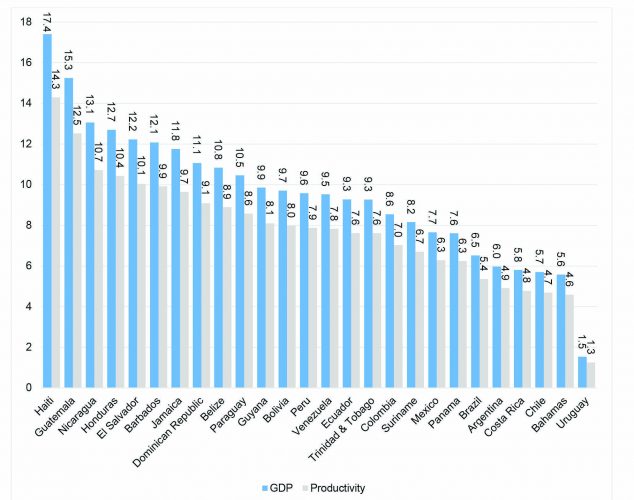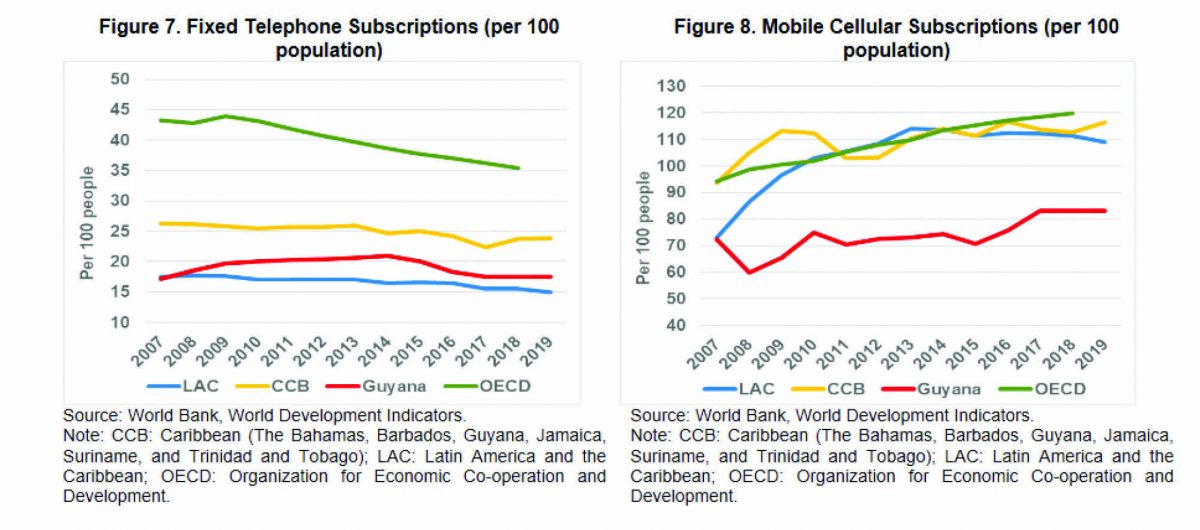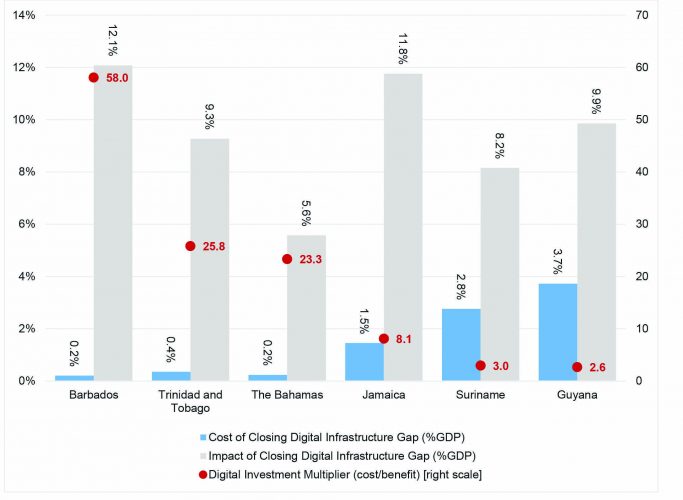While the share of the Guyanese population using the internet has risen significantly it remains below the benchmark averages of Latin America and the Caribbean as a whole.
This is according to the latest Inter-American Development Bank’s (IDB) Carib-bean Quarterly Economic bulletin which focused on closing the digital access gap and the benefits that this would bring to Guyana and the rest of the region.
Closing the digital access gap between the Caribbean and the more advanced economies could increase the region’s GDP by about 6 to 12 percent over the medium term and provide a strong boost to a post-COVID-19 recovery, the bulletin said.
Coverage of information and communication technologies here, and their utilization, is among the lowest in the region, hindering productivity and innovation. In relation to Guyana, it said that one of the most basic indicators is the share of the population using the Internet.
“In Guyana, this percentage rose from 13.8 percent in 2007 to 37.3 percent in 2019, a significant increase but below the benchmark averages of Latin America and the Caribbean as a region and the Caribbean as a sub -region over the same period. In fact, averages of the share of the population using the Inter-net both for Latin America and the Carib-bean as a region (61 percent) and the Caribbean as a sub -region (64 percent) increased at a higher rate than in Guyana in 2019. The same rate in OECD countries was 82 percent of the population in 2018”, the bulletin said.
It said that this is a distinct measure of the technology gap separating Guyana from other countries in the region and improving it could significantly boost productivity.
“Similarly, in terms of the fixed broadband subscriptions per 100 population, Guyana trails the group of selected comparators, increasing from 0.31 subscriptions per 100 population in 2007 to 8.3 in 2019. The averages in 2019 for Latin America and the Caribbean as a region and the Caribbean as a sub -region were 12.7 and 19.3, respectively, well below the OECD average of 31.4 in 2018”, the bulletin said.
In terms of telephone communications indicators, Guyana is below the regional averages in both fixed and mobile communications subscriptions per 100 population. Fixed telephone subscriptions per 100 population have dropped in Guyana and in all selected benchmark comparators.
“In Guyana they declined from 20.1 fixed telephone subscriptions per 100 population in 2014 to 17.5 in 2019. Overall, there are more fixed subscriptions per population in Guyana than in Latin America and the Carib-bean on average, where they declined from 16.5 in 2014 to 14.9 in 2019. However, the Caribbean has higher average subscriptions per 100 population, reaching 23.8 in 2019. The declining trend in fixed mobile subscriptions is potentially due to increasing mobile cellular subscriptions per 100 population. In Guyana mobile subscriptions per 100 population increased from 59.9 in 2008 to 82.9 in 2019, compared to the averages of 108.9 for Latin America and the Caribbean as a region and 116.4 for the Caribbean as a sub –region”, the bulletin said.
The bulletin said that an additional measure of digital technology development is the United Nations’ E -Government Development Index (EGDI), which assesses the adoption of technology in the delivery of public services and benchmarks in 193 UN member countries based on three equally weighted components: telecommunications infrastructure, human capital, and online services, which assesses the national online presence.
The EGDI ranges from 0-1 and groups countries in four categories: very high EGDI (0.75- 1.00), high EGDI (0.50- 0.75), middle EDGI (0.25- 0.50), and low EGDI (0.00- 0.25).
“In 2020, Guyana ranked 129th and was in the middle EDGI grouping with a score of 0.49. On the components making up the index, all ranging from 0- 1, Guyana was evaluated as having high human capital (0.64), mid- level telecommunications infrastructure (0.36), and, on the measure that is most related to e- government, mid-level online services (0.46)”, the bulletin said.
Among other Caribbean countries, Barbados was ranked the highest at 62nd, The Bahamas 73rd, Trinidad and Tobago 83rd, Jamaica 114th, and Suriname 122nd. The bulletin said that a study by the IDB in 2019 entitled “The Impact of Digital Infrastructure on the Sustainable Development Goals” estimates the digital infrastructure gap for several Latin American and Caribbean countries relative to OECD levels. It highlights the positive impact of telecommunications infrastructure on several UN Sustainable Development Goals (SDGs) such as ending poverty (SDG1), zero hunger (SDG2), good health and well -being (SDG3), and decent work and economic growth (SDG8), among others.
The bulletin said that the main recommendation in the study i s that, due to evidence showing that telecommunications infrastructure spurs sustainable development, investment in digitalization and related- infrastructure should be strongly incentivized. The bulletin said that the authors of the study applied the same methods to Caribbean countries to interrogate the cost of closing the infrastructure gap relative to OECD economies and its impact on GDP.
The details of the costs in the figure include infrastructure gap estimates for Guyana for fixed and broadband investments as well as urban versus rural investments. The total estimate for this specific infrastructure gap in Guyana is US$178 million, of which US$135 million relates to fixed broadband infrastructure and US$43 million to mobile broadband infrastructure. That, the bulletin said, translates to 3.09 percent of nominal GDP.
Infrastructure investments in urban areas are estimated at US$19.5 million, while in rural areas they are estimated at US$158.5 million. The bulletin said that Guyana’s current levels of government capital expenditure are US$495 million, or 8.5 percent of 2020 GDP. The empirics of the study, which focused on 26 Latin American and Caribbean countries, found that an increase in digital infrastructure investment of 1 percent contributed to expanding GDP by 0.319 percent, suggesting telecommunications investments leverage GDP growth, primarily through the direct effects of building infrastructure and, indirectly, by increasing communications, innovation, and productivity.
For Guyana, the bulletin said that an investment in telecommunications of 3.09 percent of GDP would contribute to increasing GDP by 9.86 percent, having a “multiplier” effect.
Policy developments
The bulletin noted that in October 2020, the government announced the end of the 30-year telecommunications monopoly by fully implementing the liberalization measures of the 2016 Telecommunications Act. In February 2021 it noted that the government announced licensing exemptions for approximately 50 small Internet service providers in order to strengthen the telecommunications sector and expand Internet coverage to 200 remote rural communities in Guyana’s hinterland. As a result of the policy change, the bulletin noted that private operators immediately announced lower rates for mobile communications and the expansion of Internet services to previously unserved locations.
It was also pointed out that in 2018, the government engaged authorities of the government of Estonia in collaboration with the IDB to cooperate on the development of a Digital Governance Roadmap for the government of Guyana, considering Estonia’s progress in communications technology and e -government over recent decades. The document was completed that year, with key recommendations for governance, coordination across agencies, updating of legislation, infrastructure, and cybersecurity, among other areas. Another ongoing government programme is the National Broadband Expansion Project, which is funded by a US$37.6 million loan from the government of China, with the objective of expanding and upgrading the E -government network.
The bulletin said that oil and gas developments in Guyana point to the importance of strengthening information and telecommunications infrastructure.
“Oil and gas production are data -intensive industries requiring expanded storage and sharing capacity, as well as data management systems to inform decision- making in both the private and public sectors. “Oil producers use advanced technologies for 3- D seismic imaging and are also advancing in connectivity to improve productivity. These developments put additional pressure on governments to advance their information and communications capacity to store and process growing volumes of information. In this context, oil producers in Guyana are planning to connect their offshore and onshore operations with fibre optic cable for improved data transmission and process monitoring, which is expected to also support government oversight of oil production”, the bulletin noted.
Figure. Estimated GDP and Productivity Gains from Closing Digital Infrastructure Gaps in Latin America and the Caribbean (percent)
 Benefits versus Costs of Closing Digital Infrastructure Gaps in Caribbean Countries (percent of GDP and multiplier)
Benefits versus Costs of Closing Digital Infrastructure Gaps in Caribbean Countries (percent of GDP and multiplier)










